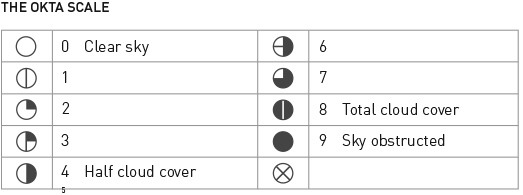octa | /ˈɒktə/

In meteorology, an okta (or octa) is the unit of measurement used to determine cloud cover. It derives from the Greek ocktá for eight. The okta scale is usually expressed using a set of circular symbols, each of which has a corresponding numerical value. Counter-intuitively, the complete okta scale does not run from 1 to 8 but from 0 to 9. This is because 0 represents entirely clear skies, and 9 indicates the sky is obscured by low-level weather such as fog.
To measure the cloud cover using the okta scale, you need to first divide the sky into eighths – the easiest way to do this being to mark a mirror and then lay it flat to reflect the sky. If the sky is full of roarie-bummlers (a Scottish term for fast-moving storm clouds), using a camera to capture a still image may be required. The number of eighths with any cloud determines the number on the okta scale. The results are generally rounded up rather than down – three and one-quarter oktas being recorded as four. The exception to this rule is when there is more than seven but less than eight, in which case, the number is rounded down as eight is reserved for total cloud cover.

Introduction Aeolian Alpenglow
Benthos Crepuscular Crispate Crown shyness
Desire lines Dreich Endragoned Edgelands
Frondescence Fumarole Gluggaveður Gossamer
Karst Komorebi Lawrence Long acre
Machair Monkey’s wedding Moonglade
Psithurism Quartz Rakuyou Roaring forties
Snag Soft estate Specular, diffuse and pellucid
Spoondrift Steam fog Swash zone Sylvan